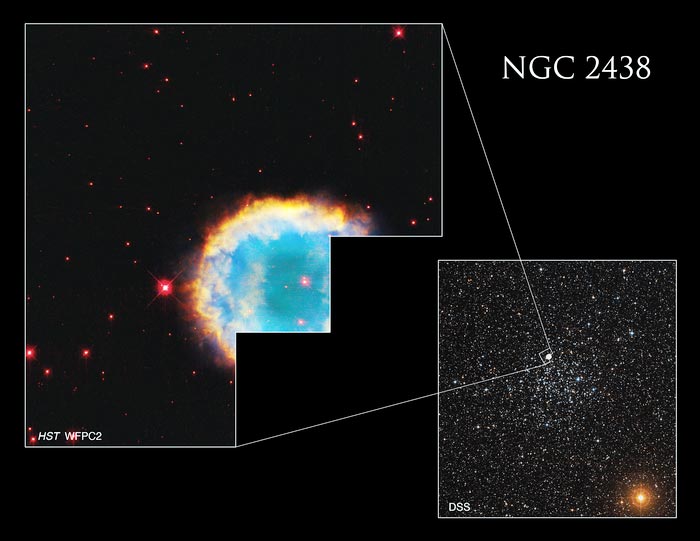Hubble Images Colorful Planetary Nebula Ringed by Hazy Halo

The colorful planetary nebula, NGC 2438, appears to lie on the outskirts of the open star cluster, M46 (NGC 2437). The nebula is actually in the foreground between us and the star cluster.
Credits: NASA, ESA, K. Knoll (NASA Goddard), S. Öttl (Leopold Franzens Universität Innsbruck), et. al., and DSS; Processing: Gladys Kober (NASA/Catholic University of America)
NGC 2438 is a planetary nebula, formed after the death of a Sun-like star. The medium-sized star would have expelled its outer layers of gas into space as it died, leaving behind a white-dwarf core.
A halo of glowing gas over 4.5 light-years across surrounds the nebula’s brighter inner ring. Many round or nearly round planetary nebulae display these halo structures, and astronomers have been investigating how they evolve.
NGC 2438 was one of the nebulae studied, and researchers found that the nebula’s halo glows due to the ionizing radiation of the central white dwarf.
In this color-filled image, blue represents oxygen (O III), green is hydrogen (H-alpha), orange is nitrogen (N II), and red is sulfur (S II).
This Hubble Space Telescope image was captured by Hubble’s Wide Field and Planetary Camera 2, which gave it its distinctive stair-shape. One of the camera’s four detectors provided a magnified view, which would be shrunk down in the final image to match the other three, creating the unique shape.
For more information on the Wide Field and Planetary Camera 2 image shape, visit: https://www.nasa.gov/content/about-facts-hubble-faqs.
Media Contacts
Robert Gutro
NASA/Goddard Space Flight Center
robert.j.gutro@nasa.gov
Office: 301-286-4044
Claire Andreoli
NASA Goddard Space Flight Center
claire.andreoli@nasa.gov
All latest news from the category: Physics and Astronomy
This area deals with the fundamental laws and building blocks of nature and how they interact, the properties and the behavior of matter, and research into space and time and their structures.
innovations-report provides in-depth reports and articles on subjects such as astrophysics, laser technologies, nuclear, quantum, particle and solid-state physics, nanotechnologies, planetary research and findings (Mars, Venus) and developments related to the Hubble Telescope.
Newest articles

Superradiant atoms could push the boundaries of how precisely time can be measured
Superradiant atoms can help us measure time more precisely than ever. In a new study, researchers from the University of Copenhagen present a new method for measuring the time interval,…

Ion thermoelectric conversion devices for near room temperature
The electrode sheet of the thermoelectric device consists of ionic hydrogel, which is sandwiched between the electrodes to form, and the Prussian blue on the electrode undergoes a redox reaction…

Zap Energy achieves 37-million-degree temperatures in a compact device
New publication reports record electron temperatures for a small-scale, sheared-flow-stabilized Z-pinch fusion device. In the nine decades since humans first produced fusion reactions, only a few fusion technologies have demonstrated…





















